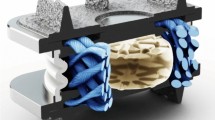Abstract
Introduction
The purpose of this study was to determine whether fusion causes adjacent segment degeneration or whether degeneration is due to disease progression.
Materials and methods
Eighty-seven patients that had undergone single level anterior cervical decompression and fusions with at least 5 years of follow-up were enrolled in this retrospective study. Segments adjacent to fusion levels (above or below) were allocated to group A, and all others were allocated to group B. Radiographic evaluations of adjacent level changes included assessments of; disc degenerative changes, anterior ossification formation, and segmental instability. The developments of new clinical symptoms were also evaluated.
Results
In group A, adjacent segment degenerative change developed in 28 segments (16%) and two cases (2%) developed new clinical symptoms. In group B, adjacent segment degenerative change developed in 10 segments (3%), and two cases (0.7%) also developed new clinical symptoms. Additional operations were performed in one patient in each group.
Conclusion
Although, fusion per se can accelerate the severity of adjacent level degeneration, no significant difference was observed between adjacent and non-adjacent segments in terms of the incidence of symptomatic disease. The authors conclude that adjacent segment disease is more a result of the natural history of cervical spondylosis than the presence of fusion.

Similar content being viewed by others
References
Baba H, Furusawa N, Imura S, Kawahara N, Tsuchiya H, Tomita K (1993) Late radiographic findings after anterior cervical fusion for spondylotic myeloradiculopathy. Spine 18:2167–2173
Bertagnoli R, Yue JJ, Pfeiffer F et al (2005) Early results after ProDisc-C cervical disc replacement. J Neurosurg Spine 2:403–410
Caspar W, Geisler FH, Pitzen T, Johnson TA (1998) Anterior cervical plate stabilization in one- and two-level degenerative disease: overtreatment or benefit? J Spinal Disord 11:1–11
Dvorak J, Froehlich D, Penning L, Baumgartner H, Panjabi MM (1988) Functional radiographic diagnosis of the cervical spine: flexion/extension. Spine 13:748–755
Eck JC, Humphreys SC, Lim TH et al (2002) Biomechanical study on the effect of cervical spine fusion on adjacent-level intradiscal pressure and segmental motion. Spine 27:2431–2434
Goffin J, Geusens E, Vantomme N (2004) Long-term follow-up after interbody fusion of the cervical spine. J Spinal Disord Tech 17:79–85
Goffin J, Van Calenbergh F, van Loon J et al (2003) Intermediate follow-up after treatment of degenerative disc disease with the Bryan cervical disc prosthesis: single-level and bi-level. Spine 28:2673–2678
Goffin J, Van Loon J, Van Calenbergh F, Plets C (1995) Long-term results after anterior cervical fusion and osteosynthetic stabilization for fractures and/or dislocations of the cervical spine. J Spinal Disord 8:500–508
Gore DR (2001) Roentgenographic findings in the cervical spine in asymptomatic persons. A ten year follow-up. Spine 26:2463–2466
Henriksen M, Lund H, Moe-Nilssen R et al (2004) Test-retest reliability of trunk accelerometric gait analysis. Gait Posture 19:288–297
Herkowitz HN, Kurz LT, Overholt DP (1990) Surgical management of cervical soft disc herniation: a comparison between the anterior and posterior approach. Spine 15:1026–1030
Hilibrand AS, Carlson GD, Palumbo MA, Jones PK, Bohlman HH (1999) Radiculopathy and myelopathy at segments adjacent to the site of a previous anterior cervical arthrodesis. J Bone Joint Surg Am 81:519–528
Kalfas IH (2002) Role of corpectomy in cervical spondylosis. Neurosurg Focus 12:E11
McGrory BJ, Klassen RA (1994) Arthrodesis of the cervical spine for fractures and dislocations in children and adolescents. A long-term follow-up study. J Bone Joint Surg Am 76:1606–1616
Park JB, Cho YS, Riew KD (2005) Development of adjacent-level ossification in patients with an anterior cervical plate. J Bone Joint Surg Am 87:558–563
Pimenta L, McAfee PC, Cappuccino A, Bellera FP, Link HD (2004) Clinical experience with the new artificial cervical PCM (Cervitech) disc. Spine J 4:315S–321S
Sekhon LH (2004) Cervical arthroplasty in the management of spondylotic myelopathy: 18-month results. Neurosurg Focus 17:E8
Smith GW, Robinson RA (1958) The treatment of certain cervical-spine disorders by anterior removal of the intervertebral disc and interbody fusion. J Bone Joint Surg Am 40:607–624
Song KJ, Lee SK, Song JH, Choi BY (2009) The comparison of multi-level fusion versus one-level fusion to the development of adjacent level degeneration in anterior cervical arthrodesis with PEEK cage and plate augmentation for the degenerative cervical spinal disorders. J Korean Orthop Assoc 44(6):613–618
Teramoto T, Ohmori K, Takatsu T et al (1994) Long-term results of the anterior cervical spondylosis. Neurosurgery 35:64–68
Conflict of interest
None.
Author information
Authors and Affiliations
Corresponding author
Rights and permissions
About this article
Cite this article
Song, KJ., Choi, BW., Jeon, TS. et al. Adjacent segment degenerative disease: is it due to disease progression or a fusion-associated phenomenon? Comparison between segments adjacent to the fused and non-fused segments. Eur Spine J 20, 1940–1945 (2011). https://doi.org/10.1007/s00586-011-1864-9
Received:
Revised:
Accepted:
Published:
Issue Date:
DOI: https://doi.org/10.1007/s00586-011-1864-9




